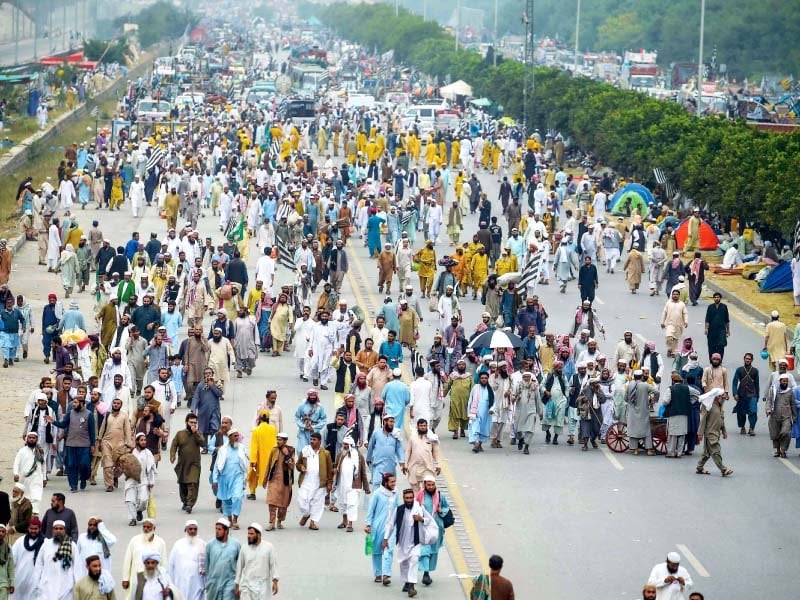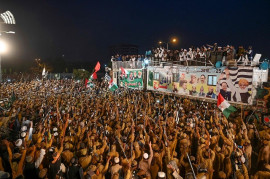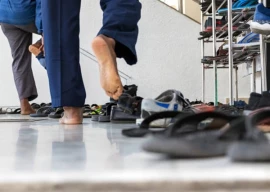
ISLAMABAD: Having spent a third night in Sector H-9 of the capital, participants of the massive Azadi march led by the Jamiat Ulema-e-Islam-Fazl (JUI-F) and allied parties are starting to feel more at home as they go about their mundane tasks and even indulging in some recreational activities.
Like clockwork, participants of the march arose en masse early on Sunday morning to offer their morning prayers after tending to the calls of nature and performing their ablutions.
The prayers were followed by the Ansarul Islam (AI), the militia of the JUI-F which is guarding protesters and keeping a keen watch on proceedings, undergoing a change of guard in an elaborate ceremony. Thereafter the AI held their security drills to keep their members on their toes.
As the sun rose, many protesters headed to nearby markets, particularly in Sector G-10 to purchase various items of daily-use along with foodstuff to maintain their energy levels.
Azadi march participants hunker down in capital
Cleaning spree
After their morning routine, many participants packed up their beds and got to cleaning the small patches of land they have been calling home for the past few days. The protesters cleaned the venue on a self-help basis.
Curiously, though, most did not have any brooms to clean up the area with. Instead, they took to breaking off branches from nearby trees on the greenbelt to use as makeshift brooms to clean up the area.
Recreational activity
Having little to do for the most of the day when there was scant activity atop the main stage composed of containers, many rally participants found things to keep themselves busy.
Some buried themselves into books they had brought while others took to using their smartphones to keep themselves entertained and up to date on the latest occurrences.
Others still decided to pass the time with some sports. The added benefit being that they could beat the chilly weather with some physical exercise that came with the games.
In this way, may were seen playing football. In one video from the march which has been shared widely on social media, a group of over ten young protesters could be seen jostling for the ball on a closed-off section of the Kashmir Highway. The youngsters appeared to play futsal on the road, having made the goalposts by placing slippers and shoes with a short distance between them.
Several other participants gathered by the greenbelt to watch the friendly match and ever so often, someone from the audience would make a gesture about the way the match was being played.
Utilizing solar energy
With the protest venue far from any power outlet, many participants had trouble keeping in contact with their loved ones and even one another.
Fortunately, some of the protesters had brought with them solar panels to which they could connect their devices. A rush was thus seen in the tent village wherever there was a solar panel as people clumped around it to charge their devices.
A sunny day in the federal capital made things easier to charge phones, torches and other chargeable equipment.
Protesters said that it was important to keep their phones on as many of them had travelled thousands of kilometres from their homes to participate in the protest.
Although the government has restricted cellular signals at the protest venue, limiting mobile broadband but allowing calls and text messages in some sports, marchers said they could access the internet if they walked away few kilometres (km) from the protest site. There, they said, they can access information about what was going on and even update their social media accounts about happenings inside the camps and combat negative propaganda being spread against them.
“Walking a distance of four kilometres will make us healthy and fit while we upload our videos as well,” said one JUI-F worker.
The free sharing of power for charging mobile phones with other participants has also helped create harmony among the march participants who come from across the country and from varying backgrounds.
Owners of the panels said that they had travelled to the march as brothers and there was no reason to become possessive about possessions from which their brothers can benefit.
Food street sprouts up in Azadi march tent village
Containers become homes
Since not every participant brought their tent and the weather turning a little chilly upon their arrival in the federal capital, the protesters have started using the containers placed by the Islamabad Capital Territory Administration (ICTA) for restricting their movement in the high-security zones, as a dwelling.
Protesters, who have taken up positions near Peshawar Mor and are waiting for signals from their leadership on what to do next, have taken to sleeping inside the very containers which are supposed to box them in.
Instead of wasting time on removing the barricades or launching complaints, they have accepted the containers as their shelter.
The security arrangements around the main containers have been made by volunteers of Ansarul Islam.
Various stalls have been set up near the protest venue where items are available at market price. Food, drinks, fruit chat, dahi bhalle, and tea stalls were commonly seen being visited by the marchers. Dry fruits and water bottles are also being sold.
The participants of the march could also be seen washing their clothes and performing ablutions for prayers in nearby mosques.
Published in The Express Tribune, November 4th, 2019.


































































COMMENTS
Comments are moderated and generally will be posted if they are on-topic and not abusive.
For more information, please see our Comments FAQ